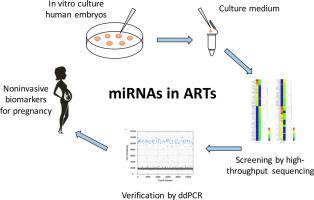Journal of Advanced Research ( IF 11.4 ) Pub Date : 2021-01-11 , DOI: 10.1016/j.jare.2021.01.003 Fang Fang 1, 2 , Zili Li 1, 3 , Jiangyu Yu 1 , Yuting Long 3 , Qian Zhao 1 , Xiaofang Ding 2 , Li Wu 4 , Shumin Shao 3 , Ling Zhang 1, 3 , Wenpei Xiang 1, 3

|
Introduction
MicroRNAs (miRNAs) are important regulators of many biological functions, including embryo implantation and development. Recently, it has been reported that miRNAs in biofluids are predictive for physiological and pathological processes.
Objectives
In this study, we aim to investigate whether the miRNAs secreted by human embryos in culture medium can be used as embryonic biomarkers.
Methods
The culture media were prospectively collected from embryos of patients at reproductive medicine center with informed consent. A high-throughput miRNA sequencing method was applied to detect the miRNA profiles in the human embryo culture media. After bioinformatics analysis and screening of differentially expressed miRNAs, quantitative real-time polymerase chain reaction (qRT-PCR) assay was subsequently performed to further confirm the sequencing results with mixed samples. Furthermore, we performed droplet digital PCR (ddPCR) to verify the target miRNAs at single sample level. Receiver operating characteristic (ROC) analyses were performed for differentially expressed miRNAs.
Results
Compared with embryos with failed pregnancy, the embryos with successful pregnancy secreted different miRNA profiles into the culture media, which were predicted to be involved in multiple biological processes. Validated by droplet digital polymerase chain reaction (ddPCR), the expression of hsa-miR-26b-5p and hsa-miR-21-5p in the culture media of cleavage embryos with successful pregnancy was significantly lower than that of embryos with failed pregnancy. Moreover, the Receiver Operating Characteristic (ROC) curve analysis indicated that hsa-miR-26b-5p and hsa-miR-21-5p could serve as potential biomarkers for reproductive outcomes.
Conclusion
Together, our findings highlight the important predictive potential of miRNAs secreted by human embryos in culture media, which is meaningful for non-invasive embryo selection in assisted reproductive technology.
中文翻译:

人类胚胎分泌的微小RNA可能成为辅助生殖技术临床结果的潜在生物标志物
介绍
MicroRNAs (miRNAs) 是许多生物学功能的重要调节剂,包括胚胎植入和发育。最近,据报道,生物体液中的 miRNA 可预测生理和病理过程。
目标
在这项研究中,我们旨在研究培养基中人类胚胎分泌的 miRNA 是否可以用作胚胎生物标志物。
方法
在知情同意的情况下,从生殖医学中心的患者胚胎中前瞻性地收集培养基。应用高通量 miRNA 测序方法检测人类胚胎培养基中的 miRNA 谱。在对差异表达的 miRNA 进行生物信息学分析和筛选后,随后进行定量实时聚合酶链反应 (qRT-PCR) 分析以进一步确认混合样本的测序结果。此外,我们进行了液滴数字 PCR (ddPCR) 以验证单个样本水平的目标 miRNA。对差异表达的 miRNA 进行了受试者工作特征 (ROC) 分析。
结果
与怀孕失败的胚胎相比,成功怀孕的胚胎向培养基中分泌了不同的miRNA谱,预计这些miRNA参与了多种生物学过程。通过液滴数字聚合酶链反应(ddPCR)验证,成功妊娠卵裂胚胎培养基中hsa-miR-26b-5p和hsa-miR-21-5p的表达明显低于妊娠失败胚胎。此外,接受者操作特征 (ROC) 曲线分析表明 hsa-miR-26b-5p 和 hsa-miR-21-5p 可以作为生殖结果的潜在生物标志物。
结论
总之,我们的研究结果突出了人类胚胎在培养基中分泌的 miRNA 的重要预测潜力,这对于辅助生殖技术中的非侵入性胚胎选择具有重要意义。











































 京公网安备 11010802027423号
京公网安备 11010802027423号